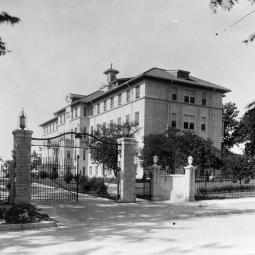Description
1916-18 Main Building
Harry James Manning designed the three and one half -story building in the Italian Renaissance Revival style. News accounts of the time describe the Mullen home as “constructed of gray brick with terracotta trimmings". North, south and west wings that form a "T” make up the main building. The north and south residential wings extend approximately 200 feet in length and are 55 feet in width. A truncated hip roof of red tile covers the residential wings. A cupola is centered at the T crossing. Small shed roof dormers provide venting. A projecting terra-cotta string course runs along the facades at the window sill level of the top floor. Projecting brick detailing forms quoining at the corners of the building. Vertical bands of brickwork with darker red colored mortar is found between the windows. Historic photos show 6 over 6 and 4 over 4 double hung windows. Most of the current window sash appears to have been changed, though window locations and sizes appear unchanged. East and north1st floor windows are headed with blinded arches.
The symmetrical east facade presents 18 bays. A richly decorated arched portico at the center of the east facade shelters the main entry . Located above the arched entry portico is a cartouche inscribed "JK Mullen Memorial to the Little Sisters of the Poor". An additional inscription at the fascia of the entry arch completes the dedication with “Home for the Aged". A niche above the cartouche holds a statue. The installation of this statue occurred subsequent to original construction, probably between 1925 to 1935.
The west wing houses the Chapel. The Chapel wing measures approximately 75 feet long and 36 feet wide with an apse at the west end. The Chapel's roof is also of red tile with a gable form. Venting is provided by four small gable dormers. The north and south walls of the chapel have tall multi light windows with a blinded half round arches at the head.
Out buildings at west perimeter include a 1920s? west garage, the 1932 Recreation Bldg and the late1920s? Laundry. Design style and materials of these emulate the main building. The north garage & northeast residence/office bldg date to after 1950.
1973 Annex
The Annex building reflects a Modern/Formalist architectural style in a three-story brick structure. This is situated immediately south of the Main Building. A flat roof with a mansard like perimeter feature of composite shingles covers the building. The facility's footprint creates an inverted "V" form opening to the south. Approximate dimensions for each wing of the "V” are 130 feet length and a width of 55 feet in width. Along the north and south facades, balconies serve the 2nd and 3rd floors. The balconies are sheltered by an arcade with stuccoed spandrels. Stuccoed rounded arches with brick detailing support the upper balcony roof. The southeast and southwest walls are largely blank walls of brick. The center area of both walls feature a narrow stuccoed panel that extends from 1st floor to the 3rd floor with a segmental arch detail at the head. These features are trimmed with projecting brick matching the main wall.
Landscape
A metal ornamental fence with brick masonry pillars at the entry gates and corners encloses the 8.24 acre site. The north portion of the site is relatively level with a moderate slope down to 29th Avenue. A 1938 topographic maps shows the 30th Avenue gate, aligning with Meade St, was the main vehicular entrance. The drive is shown extending to a circle in front of the main entry. With the construction of the 1973 Annex another drive extended from the circle, south to the newer parking areas. The 30th Avenue gate retains its original brick masonry walls and pillar structures. An ironwork element spanning this gate is no longer in place. Lamp fixtures atop the pillars have been changed to a differing style. Additional historic vehicular and pedestrian gates are found along Newton St and Lowell Blvd.
The east portion of the grounds, the Mullen Home Gardens, are spacious landscape lawn areas with mature trees. Within this landscape are devotional elements including the Virgin Mother grotto. In 2013/14 the Stations of the Cross were placed in the Gardens. These bronze stations are set in light colored brick and were created by contemporary liturgical sculptor Lynn Kircher.
Construction History
Construction on the Main Building began in December 1916. The main building was ready to receive residents by the summer of 1918. The home was dedicated in September 1918. Dormitories occupied the third floor; the second-floor encompassed dining room, sewing rooms, and parlor; and the basement included the men’s dining room and general kitchen. The Denver Post judged the finished building as “situated in one of the most picturesque and beautifully tree-shaded plots in Denver” and noted it was “of Italian Renaissance design.” Historic pictures of the newly-constructed building show mature trees and other landscaping remaining from the site's previous occupant, Wolff’s Sunnyside Nursery. The 1930 Sanborn map indicates the north wing as the "Women's Bldg", the south wing as the "Men's Bldg" and the west wing as the "Chapel".
Subsequent improvements to the home included a two-story clubhouse for men constructed west of the main building in 1932. The clubhouse provided men a place to smoke, talk, and play cribbage, billiards, and bridge. Also, along the west perimeter separate structures for a garage and a laundry were added. These appear on the 1930 Sanborn Map. Two newer (post 1950) buildings along the north perimeter are a garage structure and a separate residence/office.
A three-story annex was added to the Mullen Home in 1973, at the cost of $1.2 million. The new Annex could accommodate seventy-six residents in private and semiprivate rooms. The building also contained medical and dental offices, rooms for therapy, an intensive-care unit, an arts and crafts room, a lounge and two main dining rooms. A three-story connector attaches the Annex to the Main Building. Construction of the connector represents the one major exterior alteration of the Main Building.
The exteriors of the buildings and the grounds otherwise retain a very high level of historic integrity.
Historical Background
Denver industrialist and philanthropist John K. Mullen built the Mullen Home because he felt the city needed a place for the elderly poor. One of the most significant changes in West Highland neighborhood land use resulted from the construction of the Little Sisters of the Poor Mullen Home for the Aged. After years of discussions and an aborted attempt to build a home for the aged on the east side of Denver, in August 1916 JK Mullen acquired the property. Formerly this was the site of Hiram Wolff's Sunnyside Tree Nursery. Ownership was placed in the name of Hiram's second wife, Jean Avis Carver on the day of their wedding January 20 1897. Property records indicate JK's acquisition came about via a " Sheriff's Deed" reflecting an $8290.82 judgment in 1915 against Jean Avis Carver Wolff. Homeowners in this neighborhood opposed the plan, but this time Mayor Robert Speer, a longtime friend of Mullen, blocked opposition, allowing the home to be built. JK Mullen wrote, “It is the finest plot of ground in the city.”
JK had asked the Little Sisters of the Poor to come to Denver to assume operational responsibility and ownership of the property for the home. The deed conveying the land stipulated the Sisters would "...forever conduct, operate and maintain on said lands and premises a Home for Aged Poor Persons of the Caucasian or white race without restriction as to sex, religion or nationality who shall have been residents of the State of Colorado for a period of one year immediately preceding their application for admission into said Home"
In the deed to the Little Sisters, JK had also pledged another $150,000 for the development and improvement of the site. JK hired Architect Harry James Manning to design the buildings.
Architect Manning's design incorporated boarding rooms for 150 people, health clinic, dining room, library, recreation rooms and a chapel.
Work on the home began in December 1916. One year later four of the Little Sisters moved into the laundry building and began to prepare for the first residents, who would arrive when the main building was finished in 1918. Bishop J. Henry Tihen dedicated the Mullen Home on 1 September 1918.Two thousand people attended the ceremonies, including Denver’s mayor and the governor, who thanked Mullen on behalf of the state. At the time of the dedication, fifty-six people were already being cared for by the Little Sisters. Historic pictures of the newly constructed building show mature trees and other landscaping remaining from Hiram Wolff’s nursery. The final complex cost over ran the original $150,000 figure by $37,638 which JK covered.
In 1924, JK created the JK Mullen Foundation which was to be in charge of distributing his money and fundraising to benefit charitable causes after his death in 1929.
$40,000 donated by the Mullen Foundation provided for the construction of the 1932 Recreation building or "Club Ho[use]" as it was designated on the 1951 Sanborn Insurance map.
The JK Mullen Foundation donated $450,000 of the total $1.2 million for the 1973 Annex. The building contained medical and dental offices, rooms for therapy, an intensive-care unit, an arts and crafts room, a lounge and two main dining rooms. The new wings increased the total capacity of residents at the home from 97 to 140.
The Little Sisters continued to operate the home with support from public donations and financial contributions of the Mullen family. In August 2022, the Denver Archdiocese issued a press release announcing the decision to close the home after more than a century of service by The Little Sisters of the Poor. Mother Julie Horseman, LSP, provincial superior of the Little Sisters, explained: “As part of a strategic plan aimed at strengthening our ministry and the quality of our religious and community life, we Little Sisters have recognized the need to withdraw from a certain number of Homes in the United States, while at the same time dedicating our resources to much needed upgrades and reconstruction projects in others.”
Gage Davis & Associates first surveyed the site in April,1977. Following in October,1982, Barbara Norgren with the Colorado Preservation Office again surveyed the site. In October 2005 Front Range Research Associates completed a reconnaissance form of the site. They also addressed it in their "Historic Buildings Survey, Wolff Place and Carter's Addition, 2005-06 Final Survey Report" The property has been assigned as state site number 5DV622.
In September 2022, the Colorado Office of Archaeology and Historic Preservation, determined that the property appears to meet the criteria for evaluation and nomination to the National Register of Historic Places.




